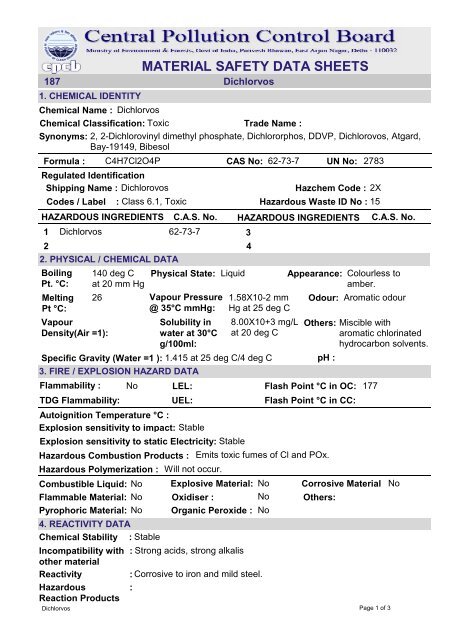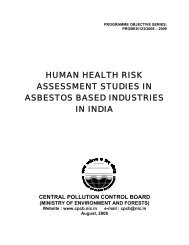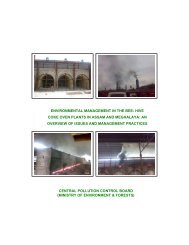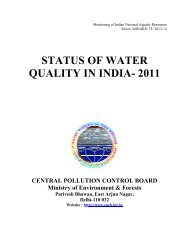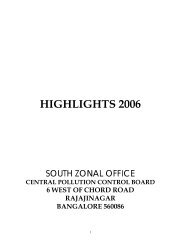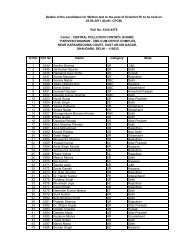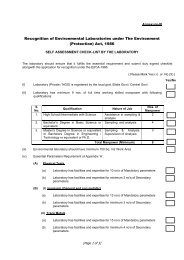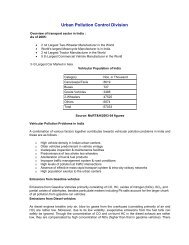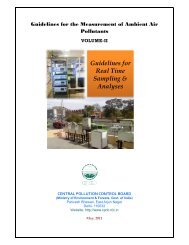187.pdf
187.pdf
187.pdf
You also want an ePaper? Increase the reach of your titles
YUMPU automatically turns print PDFs into web optimized ePapers that Google loves.
1871. CHEMICAL IDENTITYChemical Name : DichlorvosChemical Classification: ToxicTrade Name :Synonyms: 2, 2-Dichlorovinyl dimethyl phosphate, Dichlororphos, DDVP, Dichlorovos, Atgard,Bay-19149, BibesolFormula : C4H7Cl2O4PCAS No: 62-73-7 UN No: 2783Regulated IdentificationShipping Name : DichlorovosHazchem Code : 2XCodes / Label : Class 6.1, Toxic Hazardous Waste ID No : 15HAZARDOUS INGREDIENTS C.A.S. No. HAZARDOUS INGREDIENTS C.A.S. No.12Dichlorvos 62-73-72. PHYSICAL / CHEMICAL DATABoilingPt. °C:MeltingPt °C:VapourDensity(Air =1):140 deg Cat 20 mm HgPhysical State: Liquid Appearance:26 Vapour Pressure 1.58X10-2 mm Odour:@ 35°C mmHg: Hg at 25 deg CSolubility inwater at 30°Cg/100ml:348.00X10+3 mg/Lat 20 deg COthers:Colourless toamber.Aromatic odourSpecific Gravity (Water =1 ): 1.415 at 25 deg C/4 deg C pH :3. FIRE / EXPLOSION HAZARD DATAFlammability : No LEL:Flash Point °C in OC: 177TDG Flammability:UEL:Flash Point °C in CC:Autoignition Temperature °C :Explosion sensitivity to impact: StableExplosion sensitivity to static Electricity: StableHazardous Combustion Products : Emits toxic fumes of Cl and POx.Hazardous Polymerization : Will not occur.Combustible Liquid:Flammable Material:Pyrophoric Material:NoNoNoMATERIAL SAFETY DATA SHEETSDichlorvosExplosive Material:Oxidiser :Organic Peroxide :4. REACTIVITY DATAChemical Stability : StableIncompatibility with : Strong acids, strong alkalisother materialReactivity: Corrosive to iron and mild steel.Hazardous :Reaction ProductsDichlorvosNoNoNoMiscible witharomatic chlorinatedhydrocarbon solvents.Corrosive MaterialOthers:Page 1 of 3No
5. HEALTH HAZARD DATARoutes of entry: Inhalation, ingestion, skin and eyesEffects of Exposure / Symptoms:Inhalation: Dyspnea, rales, bronchorrhea, tachypnea, cheyne-stokes respiration, or apnea mayoccur, with pulmonary edema or paralysis of respiratory muscles and death in severe cases.Skin: Sweating is a consistent but not un iversal sign. Eyes: Constriction of the pupil, tearing,blurred vision and salivation are common. Prolonged dialation of the pupils may occur in severepoisonings. Ingestion: Vomiting, diarrhea, fecal incontinence, pancreatitis and abdominal painmay occur after exposure to dichlorvos.Emergency Treatment :Inhalation: Move victim to fresh air. Apply artificial respiration if victim is not breathing. Do notuse mouth-to-mouth method. Administer oxygen if breathing is difficult.Skin: Remove and isolate contaminated clothing and shoes. Immediately flush withrunning water for at least 20 minutes. For minor skin contact, avoid spreadingmaterial on unaffected skin.Eyes: Immediately flush with running water for at least 20 minutes.Ingestion: Give plenty of water or milk to drink and induce vomiting, keep air-way clear.LD50 (oral-rat) mg/kg:LC50 (rat) mg/kg:PermissibleExposure Limit:NFPA HazardSignals6. PREVENTIVE MEASURESPersonal Protective :EquipmentHandling:17 mg/kg STEL: 0.3 ppm (3 mg/m3)15 mg/m3/4 hr Odour Threshold:0.1 ppm, skin (1.0mg/m3)TLV (ACGIH) : 0.1 ppm, skin (1.0 mg/m3)Health Flammability Reactivity Special3 1 1Provide side covered safety goggles/face shield, self-containedbreathing apparatus, rubber hand gloves, body overclothing with collarand shoes.All chemicals should be considered hazardous. Avoid direct physicalcontact. Use appropriate, approved safety equipment. Untrainedindividuals should not handle this chemical or its container. Handlingshould occur in a chemical fume hood.Storage : Tightly closed containers. Keep away from heat and water, and keeparea well ventilated.Precautions : Avoid contact with liquid or vapours.7. EMERGENCY / FIRST AID MEASURESFIRE:Fire Extinguishing Media : Use foam, dry chemical, or carbon dioxide.Special Procedure : Keep the containers cool by spraying water if exposed to heat orflame.Unusual Hazards : Poisonous gases are produced.EXPOSURE: First Aid Measures:Inhalation: Move victim to fresh air. Apply artificial respiration if victim is not breathing. Do notuse mouth-to-mouth method. Administer oxygen if breathing is difficult.Skin: Remove and isolate contaminated clothing and shoes. Immediately flush withrunning water for at least 20 minutes. For minor skin contact, avoid spreadingmaterial on unaffected skin.Eyes: Immediately flush with running water for at least 20 minutes.DichlorvosPage 2 of 3
Ingestion: Give plenty of water or milk to drink and induce vomiting, keep air-way clear.Antidotes / Dosages: 2 mg Atropine (1M or IV)SPILLS :Steps To Be Taken : Shut off leaks if without risk. Contain the spillage on earth or sand.Use water spray to knock-down vapors. Land spill: Dig a pit, pond,lagoon, holding area to contain liquid or solid material.Waste Disposal Method: Absorb in vermiculite, dry sand, earth for disposing in a sanhorylandfill.8. ADDITIONAL INFORMATION / REFERENCESA Cholinesterase inliibitor. It is very rapidly metabolised and excreted.9. MANUFACTURERS / SUPPLIERS DATANAME OF FIRM :Contact personMAILING ADDRESS :in Emergency :TELEPHONE / TELEX NOS :Local Bodies involved :TELEGRAPHIC ADDRESS :Standard Packing :OTHERS :Trem Card Details / Ref :10. DISCLAIMERInformation contained in this material data sheet is believed to be reliable but no representation,guarantee or warranties of any kind are made as to its accuracy, suitability for a particularapplication or results to be obtained from them. It is up to the manufacturer/ seller to ensure thatthe information contained in the material safety data sheet is relevant to the productmanufactured / handled or sold by him as the case may be. The Government makes nowarranties expressed or implied in the respect of the adequacy of this document for anyparticular purpose.End of documentTotal No. of Pages: 3DichlorvosPage 3 of 3


